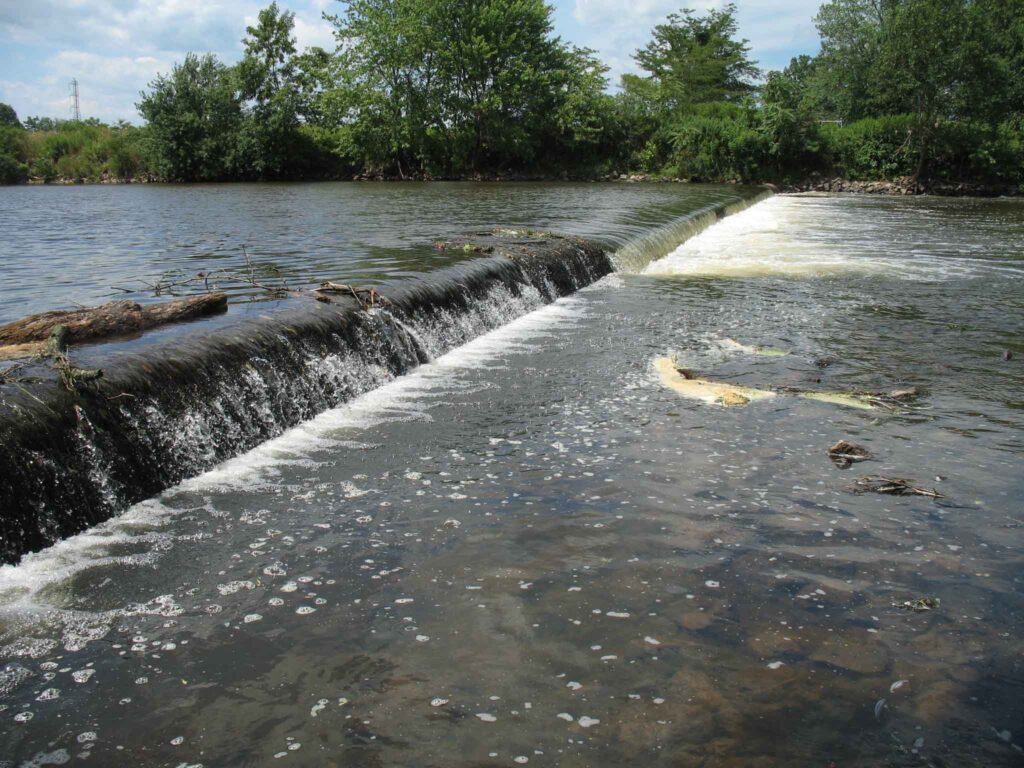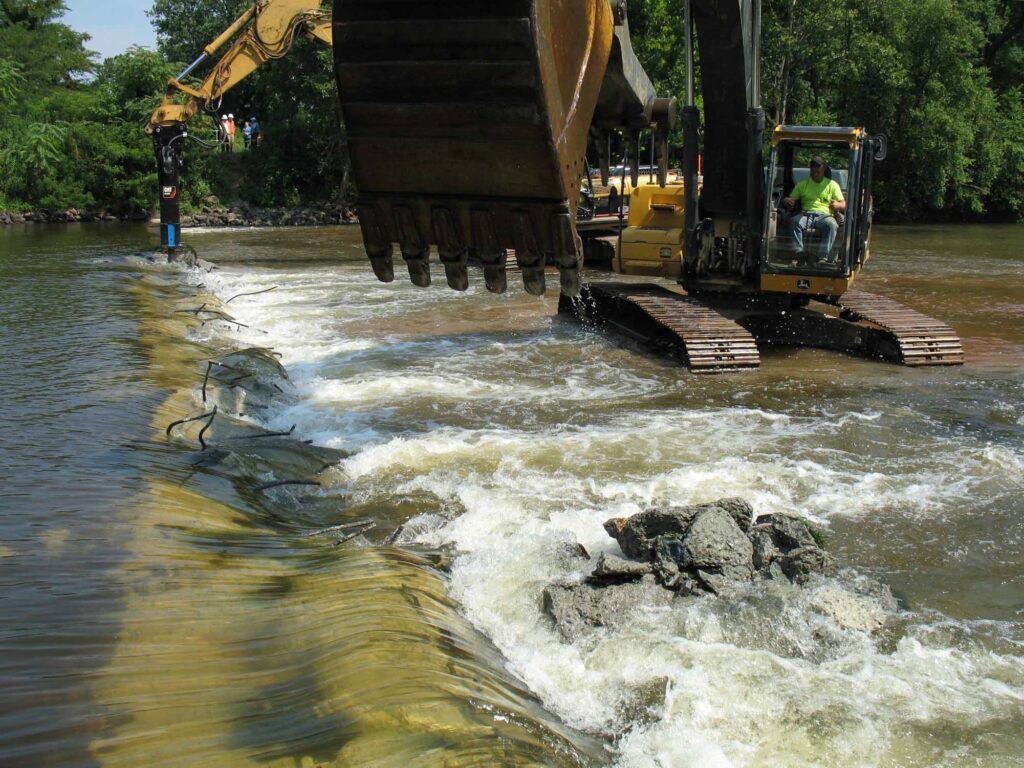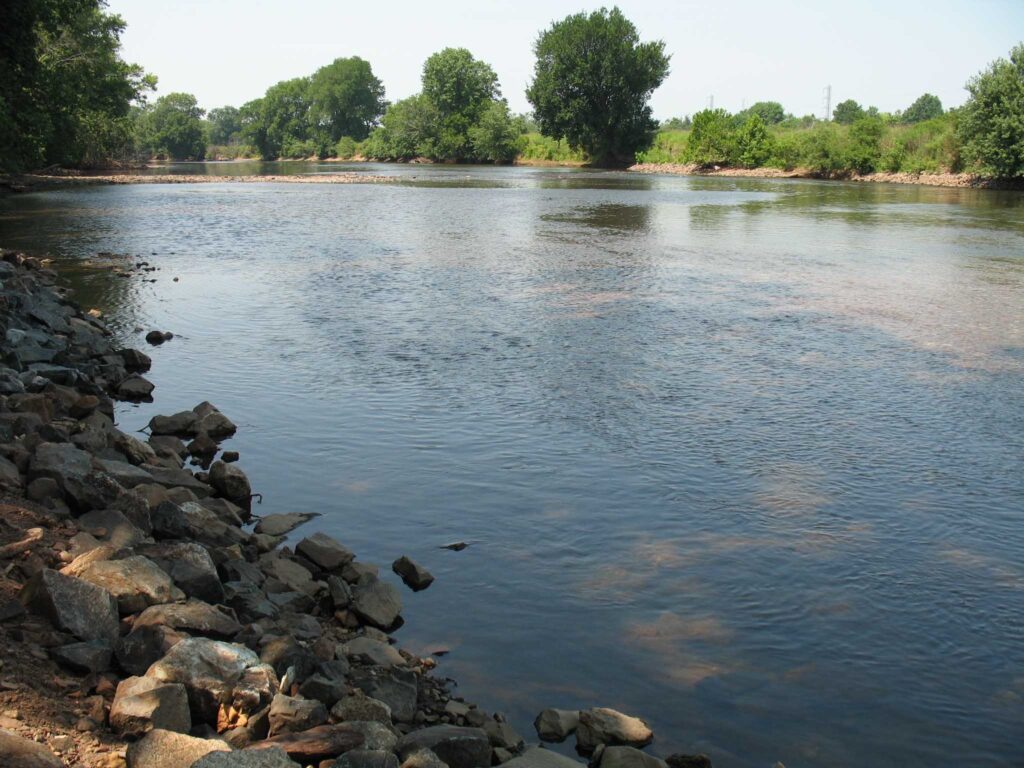Removing the Calco Dam
Article and photos by John W. Jengo
Calco Dam, positioned at Raritan River Mile (RM) 20.9, was located in Bridgewater and Franklin Townships, Somerset County, New Jersey just upriver from the Borough of Bound Brook. Calco Dam, technically a low-head loss dispersant weir, was constructed in 1938 by the Calco Chemical Company, Inc. as part of the effluent conveyance system for a synthetic dyestuff manufacturing operation that had been established at this location in 1915. To direct effluent flow to Calco Dam, a diversion structure was built on a natural stream (Cuckels Brook) 800 feet north of the dam, and as part of the diversion construction, a canal was dug from that structure to Calco Dam; a screening structure was installed at the end of the canal to prevent debris from flowing into the dispersant pipe inside the dam. The center dispersant weir section of Calco Dam was 123 feet long and was composed of a 36-inch-diameter effluent tile pipe encased in concrete, which had on its downstream side a total of 41 8-inch-diameter outlets spaced three feet apart. The weir structure was connected to the river banks by approximately 50- to 55-foot-long solid concrete abutments, making Calco Dam a run-of-the-river structure. According to the original design drawings, Calco Dam varied in width between 21.25-23 feet and it had a structural height of approximately seven feet. There was an 18-inch-thick, 12-foot-wide concrete apron extending downstream from the dam crest, ending in an apron toe section extending 3 feet below the river bed.

When the Somerset Raritan Valley Sewerage Authority (SRVSA) purchased the manufacturing site’s wastewater treatment plant operations in 1985, ownership of Calco Dam also transferred to SRVSA because the dam was an integral part of the facility wastewater effluent discharge system. Although SRVSA was utilizing Calco Dam for discharging treated municipal effluent into the Raritan River when I approached them in 2008 about removing the dam, they were already in the process of designing and permitting an alternative effluent discharge route and outfall to the Raritan River, which would allow Calco Dam to be abandoned and removed. SRVSA immediately recognized the value of eliminating the potential liability of a dam and they became the model of a cooperative dam owner in the subsequent contractual negotiations to grant us permission to remove Calco Dam.
The Calco Dam removal was successfully accomplished between July 18 and August 1, 2011, but the removal had an unique engineering component. In planning the dam removal, I ascertained that the southernmost end of the dam had been incorporated into and under the towpath berm of the historic Delaware and Raritan (D&R) Canal, although a fair portion of this dam section had been subsequently exposed by scour eddies caused by water flowing over the dam. The effect of any further excavation on the stability of the D&R Canal towpath berm was considered too risky to implement so a decision was to made to leave that southernmost section of the dam intact and rebury the section that had become exposed from the river’s scouring action. To isolate this dam section from the remainder of the structure that was to be removed required that a methodology be devised to cut through the entire dam structure with a minimal amount of disturbance to the towpath berm (the dam was much too thick to be saw cut). Taking advantage of the same scour pool that had dangerously eroded into the base of the towpath berm, we built a temporary coffer dam around this section of the dam, dewatered it, and proceeded to drill and extract dozens of overlapping 6.5-inch diameter concrete cores across the width of the dam in the process known as “stitch coring.” Once the isolation of this section of the dam was completed, we imported tons of properly-sized rock riprap and rebuilt the base of the D&R Canal towpath berm back into its original configuration with the southernmost dam fragment now serving as a stable foundation for the reconstruction. Success of this restoration was tested just a few weeks later during back-to-back record flooding events from Hurricane Irene and Tropical Storm Lee when this section of the repaired D&R Canal towpath berm held firm while other sections along the D&R Canal route suffered washouts and breaches.



The number of returning migratory fish in the Raritan River the following spring heralded the remarkable and rapid recovery of the Raritan River at the Calco Dam location. Based on observations at the upstream Island Farm Weir (IFW) fish ladder viewing window in the first spring migration season (March-May 2012) following the dam removal, the number of American shad migrating upstream increased 500% and the total number of fish passing through the IFW fish ladder increased by 200%. This essentially instantaneous result propelled the planning of the next two dam removals, which were accomplished in just the next two years (Robert Street Dam in 2012 and the Nevius Street Dam in 2013), and this succession of three dam removals in just three years is considered to be one of the most ambitious river restoration efforts that have implemented to date.

John W. Jengo, PG, LSRP is a licensed Professional Geologist in several Northeastern and Southeastern states and a Licensed Site Remediation Professional in New Jersey. John works as a Principal Hydrogeologist in an environmental consulting firm in southeastern Pennsylvania. He has degrees in geology from Rutgers University (1980) and the University of Delaware (1982). Over the last 30 years, he has conducted the characterization and remediation of large, complex contaminated industrial sites throughout New Jersey, Pennsylvania, and Delaware. He played a key role in Natural Resource Damage (NRD) assessments that led to groundbreaking legal settlements to remove numerous low head dams on the Raritan and Millstone Rivers to restore historically significant migratory fish spawning runs. As technical project manager, he planned, permitted, and successfully managed the removal of the Calco Dam, the Robert Street Dam, and the Nevius Street Dam between 2008-2013, and the removal of the Weston Mill Dam on the Millstone River in 2017, along with leading the archaeological investigation of the former Weston Mill in the Borough of Manville and Franklin Township.
